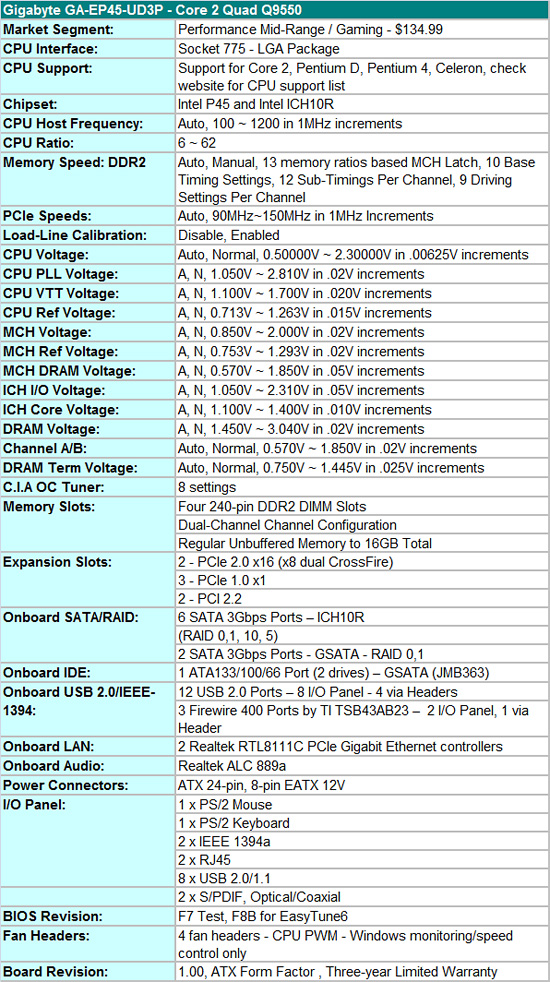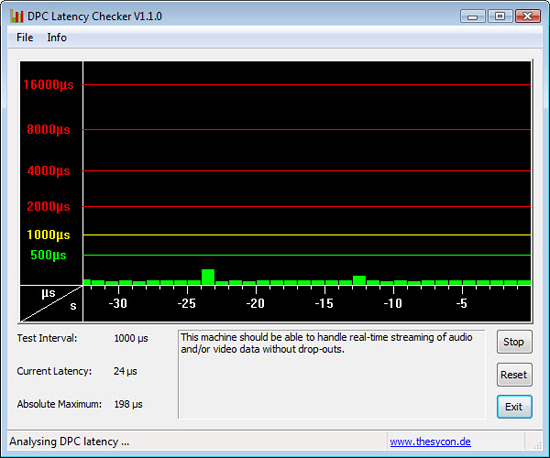Gigabyte GA-EP45-UD3P - P45 at its Finest
by Gary Key on February 3, 2009 12:15 AM EST- Posted in
- Motherboards
Gigabyte GA-EP45-UD3P
Feature Set

Gigabyte includes the standard array of components like the Realtek ALC889A HD audio codec with Dolby Home Theater support, dual Realtek RTL8111C Gigabit LAN chips with teaming support, T.I. TSB43AB23 IEEE 1394a chipset, GSATA2 (JMB363) chipset, Intel ICH10R, and full support for the Core 2 processor series, Pentium D, Pentium 4, and Celeron processors. Be sure to double check Gigabyte’s CPU support list to ensure full support for your processor.
Gigabyte also includes a rather generous accessories bundle for a motherboard in this price point. You get the standard rear I/O panel cover along with 1 x floppy cable, 1 x IDE cable, 4 x SATA cables, 1 x dual eSATA PCI expansion bracket with an eSATA cable and external molex connection, well-written and informative manual, software CD, and an illustrative installation guide.
BIOS
Gigabyte also includes one of the most extensive BIOS designs in a midrange motherboard that we have seen recently. The BIOS is setup for the serious overclocker and includes all the basic settings: CPU multiplier, PCI-E bus, Northbridge latch (FSB Strap), FSB frequency, memory multipliers, and nearly every voltage setting you will need. Gigabyte finally includes Load Load-Line Calibration (LLC) and ICH Core (Southbridge) voltage settings. LLC will help to eliminate line droop on the VCore line. We still recommend having LLC disabled in most situations, but if you have to reach a certain overclock for benchmarking, then you should probably enable it. Generally, we do not need ICH voltages in our experience but it is nice to have the feature.
Two strengths of the BIOS are the abundant voltage settings and extensive memory timing options. Gigabyte allows you to tweak tRD phase adjustments, DIMM clock skews, and memory driving strengths. For those who do not wish to tinker that much, Gigabyte provides Drive Strength Profiles (667/800/1066/OC-1200/OC-1333), which can take the guess work out of overclocking your memory. We found that these settings will get you about 98% of the way there when trying to get that last few ns in latency removed or ensuring memory stability when overclocking.
One last feature we would like to mention is the updated Q-Flash utility that is accessed via the F8 key. Q-Flash can read files directly from a USB flash drive making BIOS updating a simple and safe procedure. We tried this feature 100 times as part of our testing routine and it never failed.
We did have a couple of slight disappointments with the BIOS. In the voltage setting options, Gigabyte does not provide the base voltages that the board defaults to at startup. Our other complaint has to do with the PC Health section, as there is a lack of voltage and temperature readouts. Other than that, we were very impressed with the BIOS.
Tech
One of the most important features that Gigabyte implemented in the GA-EP45-UD3P motherboard is the Ultra Durable 3 technology. As a follow up to UD2, Gigabyte improved their component selections and electrical layout to optimize the board. Ultra Durable 3 features lower ESR solid capacitors, lower RDS(on) MOSFETs, and ferrite core chokes. Gigabyte now rates the longevity of the solid capacitors at 50,000 hours or approximately 6 years of continuous use.
The second major improvement cited by Gigabyte in their Ultra Durable 3 design is the introduction of a 2-ounce copper PCB for both the Power and Ground layers compared to the typical 1-ounce layers found in most consumer boards. Gigabyte claims this new motherboard design offers substantially lower system temperatures, superior energy efficiency, and improved overclocking. We are working on verifying the temperature and energy efficiency claims; both are certainly improved over the previous design but we need to understand if that comes from the BIOS, new heatsink design, and improved DES or if there really is something to UD3.
We have asked Gigabyte for their internal test results when it comes to board thermals and longevity of the capacitors. We would agree that overclocking is improved compared to the previous generation board. Whether that is BIOS or board design is up for debate, but considering our overclocking experiences, we think it is mostly board design. We will provide a follow-up shortly on DES and UD3; in the meantime, our simple comment is that this board is loaded and well built.
DPC Latency

We get a lot of requests for DPC latency results on each board we test. The latency variations between manufacturers utilizing the same chipset varies more than one might imagine. In the past, Gigabyte has had problems in this area. We are happy to report that it appears those problems are thing of the past, at least on this board. Our test used the E8600 at stock settings with 8GB of memory installed with timings set to 5-5-5-15 at DDR2-1066.










73 Comments
View All Comments
Glenn - Tuesday, February 3, 2009 - link
On second reading of your original post I wonder if you need to "initialize" that disk within Administrator Tools/computer management/Disk Management ? If it's showing up in device manager that is likely the problem. The cables provided by gigabyte work in any motherboard slot to any internal sata device (HD or Optical Drive) in either orientation.7Enigma - Tuesday, February 3, 2009 - link
You solved my problem! I am now in the process of formatting the drive after initializing. I have NEVER had this issue before as I guess this issue is Vista specific.I cannot thank you enough. I wish this article (and hence my question) had been up a couple days ago and saved me the several hours of wasted life. :(
Now anyone have a good (free?) ghosting program that will allow me to clone my current 80gig drive to the 250gig so I can get rid of the old PATA to use in my old computer build?
semo - Tuesday, February 3, 2009 - link
you've probably never had this problem because your drive already came with an os or the first thing you've done with a new hard drive is to install an os on it. either case, the initialization was done for you.to mirror a hard disk --> http://www.pcinspector.de/Sites/clone_maxx/info.ht...">http://www.pcinspector.de/Sites/clone_maxx/info.ht...
to take a snapshot --> http://ping.windowsdream.com/">http://ping.windowsdream.com/
http://clonezilla.org/">http://clonezilla.org/
get the source and destination right. you only get one chance!
7Enigma - Wednesday, February 4, 2009 - link
I've never directly swapped drives out like I'm trying to do here, but I have added additional drives before (all old IDE) and other than the Master/Slave issue the drives were always recognized upon reboot (with a drive letter already given). I'm sure this Vista method gives more flexibility (can have multiple drives installed but not actually recognized), but it was new and annoying to me.As for the ghost program I think I'm going to use HDclone. While the free version has slow copy times (~1gig/min), I only have an 80gig HD I'm cloning from so I don't mind a bit extra time. And according to their website they claim they now support the extra space when cloning (previously all the freeware ghost programs had the annoying habit of not adding in the rest of the space on the new HD and so you were left with creating another partition, or getting a program like partition magic to do the job the ghost program should have in the first place.
Once again than you very much for all the help and quick advice!
I'll be interested to compare boot times of Vista and games with the new drive. My current 80gig is a 7200rpm Maxtor from several years ago and while the new drive is the same spindle speed I'm assuming that the higher density will allow for quite a bit of an improvement. I'm sitting on the sideline for another year or so before jumping on the SSD bandwagon. Too rich for my blood at the moment, but I drool over them.
strikeback03 - Wednesday, February 4, 2009 - link
In XP when adding SATA drives IIRC it was normal to have to format the drive before it could be used. I don't remember initialization being a separate step though, just format the unformatted space and it would work.7Enigma - Wednesday, February 4, 2009 - link
Just wanted to say I am no running my system on my new Seagate Barracuda 7200.10 ST3250410AS 250GB 7200 RPM 16MB Cache SATA 3.0Gb/s Hard Drive, after a 2hour HDclone that worked flawlessly (and free). Not only that but the new/current version of HDclone also expanded the partition for the new larger drive so I literally just unplugged the old drive after the clone and Vista isn't even complaining to validate again (a fear I had since my copy is Vista Home Premium OEM). I didn't want to try to explain why after building my system 2 weeks ago I'm already swapping the HD....Thanks again!
7Enigma - Wednesday, February 4, 2009 - link
no = *now*7Enigma - Tuesday, February 3, 2009 - link
That sounds exactly like something that may be the culprit. As I mentioned I just made the big switch from XP to Vista, and am not used to some of the Vista policies.I thank you very much for the advice and I'll have to try this ASAP!
7Enigma - Tuesday, February 3, 2009 - link
The bios is pretty confusing when it comes to this (and the manual also doesn't help). I have made sure the SATA bios settings are NOT set to AHCI or Raid, I believe the "off" setting is for it to be seen as IDE.I kinda figured SATA didn't use the Master/Slave, but my concern is that since my primary OS drive IS a PATA drive, that there is an issue with trying to recognize a Master SATA (it shows up as master in the bios, whatever that means).
Another thing is since trying to install the SATA drive (I've since taken it out until I can find some answers) right before Vista loads the windows icon and the logon screen my HD now makes a 5-6 second grinding noise like it's searching the entire drive or something. This never happened before trying to get the SATA drive hooked up, and while it doesn't seem to have affected performance once in windows, it is a bit annoying during bootup (I keep my system off most of the time so on average boot up 2-3 times per day).
The0ne - Tuesday, February 10, 2009 - link
I'm not entirely sure of this myself not having gone through reliable tests but I've been having similar problems with HD's as of late.Make sure you only have one primary HD. If you have multiple HD set as primary, doesn't have to be active, you will run in problems. Vista chokes up as well. Make sure your HD's are labled properly when partition, Simple, Basic, Primary, etc. And then there's the odd external drive like my WorldBook 1TB that, if connected and power on, will 100% prevent XP or Vista to load up fully to the desktop (on my IP35E MB) or 100% crashes and resets the BIOS when XP/Vista tries to load (currently my EP45-DS3R MB). This WorldBook can only be connected once you're on the desktop.
I have a hate relationship with WD external drives, they just want to die in my arms for no apparent reasons.